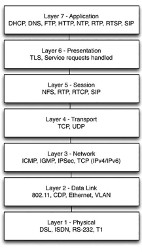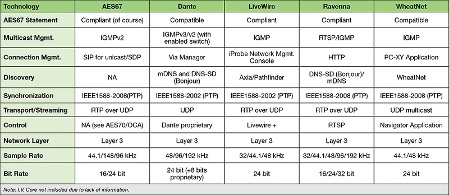The State of AoIP Compatibility
Click on the Image to Enlarge
KEEP IN MIND
Before proceeding, there are a number of items to keep in mind. First is that AES67 could be considered the lowest common denominator for successfully sending audio across a network using IP. Many pieces required to provide a complete AoIP solution— most notably discovery, management and control—are not included in AES67 and were never intended to be. Click on the Image to Enlarge
One of my missions at this year’s NAB Show was to take a deeper assessment of the state of interoperability of audio-over-IP devices in preparation for an upcoming project. I was specifically interested to see whether a complete system could be built using disparate components from different manufacturers, utilizing whatever AoIP technology had been chosen for the product.
The project is for a broadcast facility audio control room with no significant connectivity to the video router, so the key pieces are the digital audio console, intercom system, digital snakes and peripheral equipment. This system needs be configurable in minimal time with minimal hassle. All components must be guaranteed to work together and need to be as interoperable as possible, which means complying closely with AES67.
As a longtime proponent of AoIP it was my opportunity to take a closer look at what could be assembled into a functional AoIP system.
Fig. 1: OSI layers

It is also important to remember that the internet protocol (IP) can be carried over a variety of transmission paths, including Ethernet, ISDN, ATM, FireWire and DSL, making it quite versatile.
The scope of the network itself should be kept in mind, whether it will be a small internal network or one that expands outside the boundaries of a given subnet, building, campus or continent. AoIP equipment working at OSI Layer 2 will suffice for small internal networks, but any AoIP network that will roam farther afield will need to operate at Layer 3.
Finally, and most important for us, the audio settings of the technologies must match.
My mission didn’t get off to a particularly auspicious start, even before the NAB Show was underway. At the DTV Audio Group meeting the day prior to the show, Thomas Edwards, vice president of engineering at Fox, presented findings from his experiments with AoIP interoperability, concluding that interoperability wasn’t working, primarily due to transport differences.
Fortunately, he didn’t leave things there as he went on to elaborate that this situation was just temporary as video-over-IP standards were beginning to gel around SMPTE 2022 and with AES67 as the likely audio transport.
Later on in the day, Tobias Kronnenwett of Lawo, talked about how they were having continual success with AES67-based AoIP technologies on a large scale with Moto GP races, proving that the technology itself is proven in real-world use.
As I started my own examination of each AoIP technology I made the disheartening discovery that simply claiming compatibility with AES67 does not necessarily indicate that the technology is interoperable.
Table 1: AoIP compatibility matrix

In the case of Dante, upgrades made to their devices means that Dante and AES67 streams can coexist on the same network, which is about the same as having roommates— you share the same space, but that doesn’t mean you get along. In Dante’s case, they legitimately want to integrate AES67 streams, but may be hesitant to modify their robust and very successful core technology just to play nice. The players who do claim full compliance with AES67 include Ravenna and Telos, but each have their own methods for discovery, control and management to fill in the gaps.
TECHNOLOGY CHOICES
When we get down to the AoIP equipment itself we find most manufacturers making definitive technology choices, with Dante appearing to be most popular. Among large intercom systems, Delec and RTS/Omneo have chosen Dante, while Riedel has announced support for Ravenna with their Tango intercom to complement their longstanding support of AVB.
Taking a different tack, intercom vendor Clear-Com has announced their own technology called Instant Voice Core (I.V.Core) which claims AES67 compliance and which, perhaps providing the “Rosetta Stone” of the intercom world, purports to have also been tested for compatibility with AVB, Dante and Ravenna.
The world of audio console players doesn’t provide any real surprises with all the name players getting into the game, though in decidedly different ways. Digico consoles and racks can be outfitted with modules that provide Dante AoIP connectivity.
Calrec has very diplomatically decided the best way to accommodate customers is by letting them have the AoIP technology of their choosing, whether it be AES67/Ravenna, AVB, Dante or SMPTE 2022-6.
Ravenna’s parent company Lawo offers AoIP options across a large portion of their products including consoles, routers, racks and interfaces.
Dante solutions have been arriving from SSL for years and, at the 2016 NAB Show, they were showing their System T high-end, large-format broadcast console.
Wheatstone offers AoIP in five of their audio consoles and other products through Wheatnet, their AES67-compatible solution.
Finally, audio industry stalwart Yamaha offers Dante console cards and remote rack units.
Unsurprisingly, no single manufacturer makes all the equipment necessary to build an entire broadcast audio system. Very few have anything close to an entire AoIP ecosystem within their own product lines, something I find more than a little disappointing since it leaves us using an awful lot of glue to stick onto non-AoIP equipment.
The bright spot is that AoIP works and works well if all components use the same base technology. It can also be successful to a lesser degree with equipment from different manufacturers, but complete compatibility can only be guaranteed when all equipment is using the same AoIP technology.
An all-Dante system will obviously work, as will an all-Ravenna system, and any technology operating in AES67 mode will pass audio to other AES67 devices, but the method that manufacturers utilize for discovery, control and device management may mean that the components won’t know about, recognize or pass control to each other.
The challenge for my project at this stage is to choose a base technology that allows everything to work seamlessly while remaining open enough to accept other technologies as AoIP matures.
Jay Yeary is a broadcast engineer and consultant who specializes in audio. He is an AES Fellow and a member of SBE, SMPTE and TAB. He can be contacted through TV Technology or attransientaudiolabs.com.
Get the TV Tech Newsletter
The professional video industry's #1 source for news, trends and product and tech information. Sign up below.
